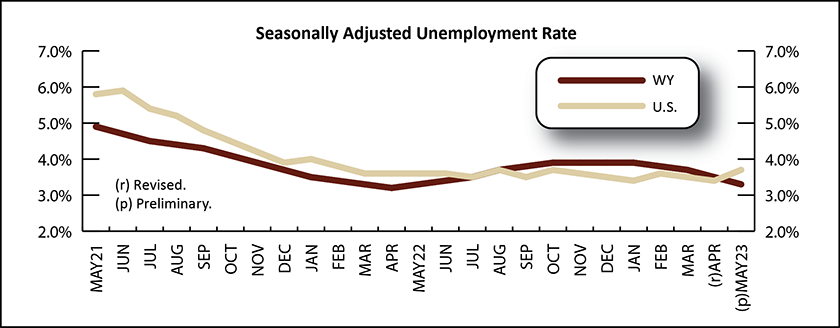Wyoming Labor Force Trends
July 2023 | Volume 60, No. 7
Click Here for PDF
Return to Table of Contents
Wyoming Unemployment Falls to 3.3% in May 2023
by: David Bullard, Senior Economist
The Research & Planning section of the Wyoming Department of Workforce Services reported that the state’s adjusted1 unemployment unemployment rate fell from 3.5% in April to 3.3% in May. Wyoming’s unemployment rate has decreased in each of the past four months and is slightly lower than the current U.S. unemployment rate of 3.7%. Seasonally adjusted employment of Wyoming residents increased by 1,351 individuals (0.5%) from April to May.
Unemployment rates fell from April to May in every area of the state. Unemployment usually decreases in May as seasonal job gains occur in many different sectors, including construction, leisure & hospitality, professional & business services, government, and retail trade. The largest decreases in unemployment were found in Teton (down from 3.9% to 2.8%), Park (down from 3.5% to 2.5%), and Sublette (down from 3.9% to 3.0%) counties.
May unemployment rates were lower than a year ago in almost every county. Niobrara County was the exception; its unemployment rate was unchanged from May 2022. The largest decreases occurred in Teton (down from 3.8% to 2.8%), Natrona (down from 3.9% to 2.9%), Washakie (down from 4.0% to 3.1%), and Converse (down from 3.1% to 2.2%) counties.
Sweetwater County posted the highest unemployment rate in May, at 3.2%. It was followed by Fremont County and Washakie County, both at 3.1%. The lowest unemployment rates were found in Weston County at 1.9%, Niobrara County at 2.1%, Crook County at 2.2%, and Converse County at 2.2%.
Total nonfarm employment in Wyoming (not seasonally adjusted and measured by place of work) rose from 284,300 in May 2022 to 290,200 in May 2023, an increase of 5,900 jobs (2.1%).
R&P's most recent monthly news release is available at https://doe.state.wy.us/LMI/news.htm.



.svg)
 Wyoming at Work
Wyoming at Work